A Comprehensive Analysis of Privacy and Security Issues in IoT
VerifiedAdded on 2023/06/11
|10
|2731
|193
Essay
AI Summary
This essay provides a comprehensive overview of the Internet of Things (IoT), focusing on its functionality, advantages, and potential privacy threats. It discusses how IoT devices, from personal gadgets to industrial equipment, collect and transmit data, enabling enhanced decision-making and process optimization. However, the essay highlights growing concerns about data breaches, corporate surveillance, and the tracking of personal information through these interconnected devices. It examines specific examples, such as smartphones, smart TVs, and voice-activated assistants, to illustrate how user data is collected and potentially misused. The essay also explores the potential of IoT in creating smart cities and improving healthcare, while emphasizing the need for robust security measures and user awareness to mitigate privacy risks. Furthermore, the essay anticipates future trends, including the integration of AI and machine learning, and the importance of addressing privacy concerns to ensure the responsible and beneficial development of IoT technologies.
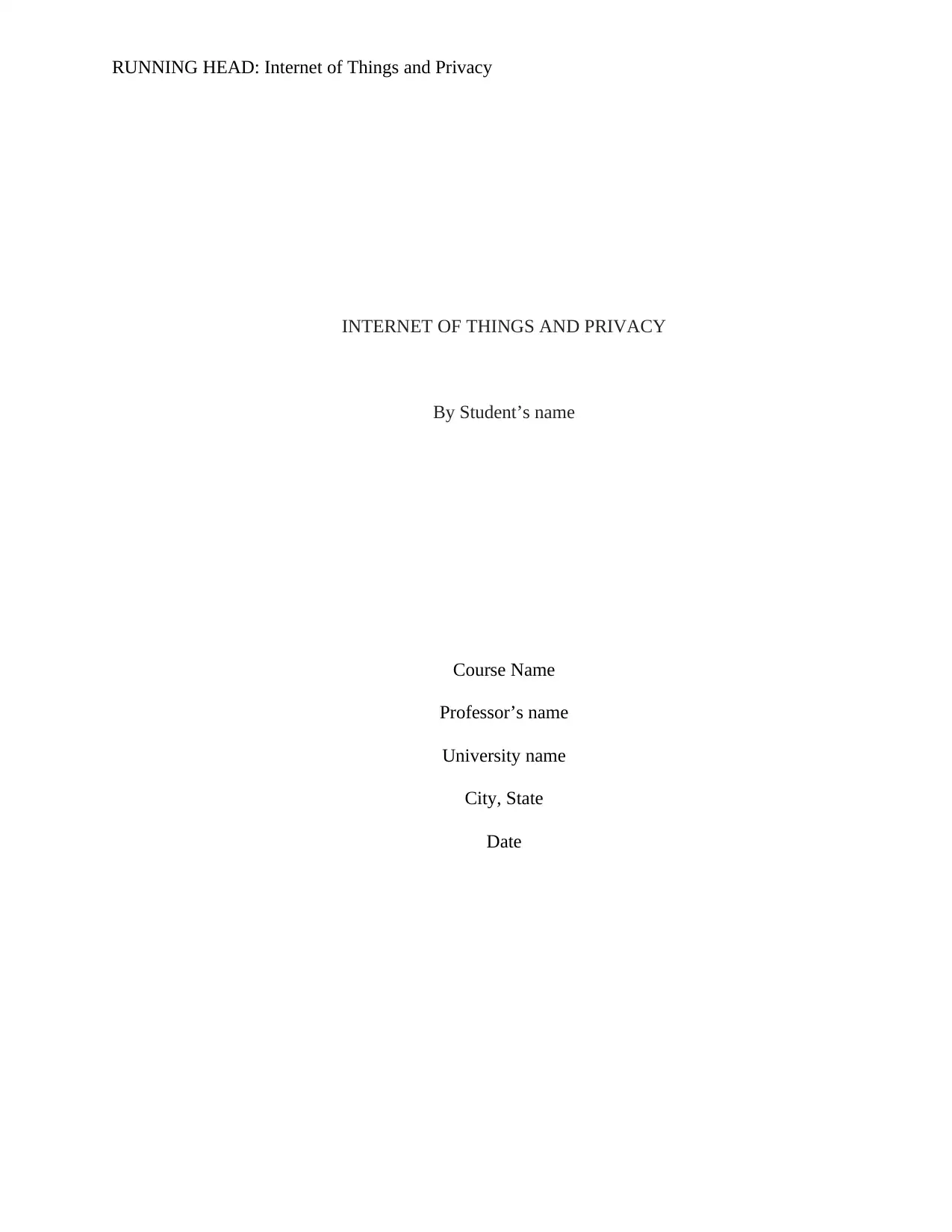
RUNNING HEAD: Internet of Things and Privacy
INTERNET OF THINGS AND PRIVACY
By Student’s name
Course Name
Professor’s name
University name
City, State
Date
INTERNET OF THINGS AND PRIVACY
By Student’s name
Course Name
Professor’s name
University name
City, State
Date
Paraphrase This Document
Need a fresh take? Get an instant paraphrase of this document with our AI Paraphraser
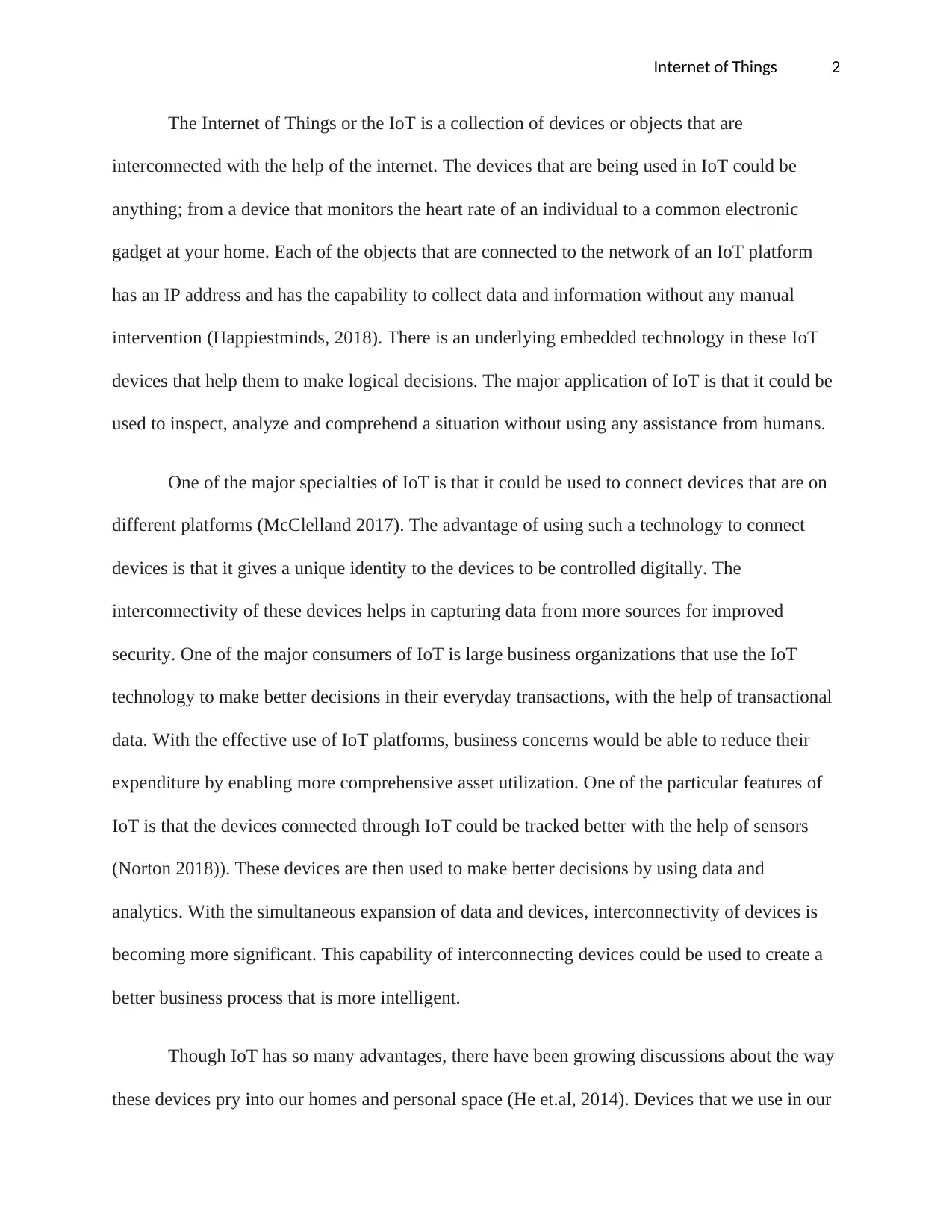
Internet of Things 2
The Internet of Things or the IoT is a collection of devices or objects that are
interconnected with the help of the internet. The devices that are being used in IoT could be
anything; from a device that monitors the heart rate of an individual to a common electronic
gadget at your home. Each of the objects that are connected to the network of an IoT platform
has an IP address and has the capability to collect data and information without any manual
intervention (Happiestminds, 2018). There is an underlying embedded technology in these IoT
devices that help them to make logical decisions. The major application of IoT is that it could be
used to inspect, analyze and comprehend a situation without using any assistance from humans.
One of the major specialties of IoT is that it could be used to connect devices that are on
different platforms (McClelland 2017). The advantage of using such a technology to connect
devices is that it gives a unique identity to the devices to be controlled digitally. The
interconnectivity of these devices helps in capturing data from more sources for improved
security. One of the major consumers of IoT is large business organizations that use the IoT
technology to make better decisions in their everyday transactions, with the help of transactional
data. With the effective use of IoT platforms, business concerns would be able to reduce their
expenditure by enabling more comprehensive asset utilization. One of the particular features of
IoT is that the devices connected through IoT could be tracked better with the help of sensors
(Norton 2018)). These devices are then used to make better decisions by using data and
analytics. With the simultaneous expansion of data and devices, interconnectivity of devices is
becoming more significant. This capability of interconnecting devices could be used to create a
better business process that is more intelligent.
Though IoT has so many advantages, there have been growing discussions about the way
these devices pry into our homes and personal space (He et.al, 2014). Devices that we use in our
The Internet of Things or the IoT is a collection of devices or objects that are
interconnected with the help of the internet. The devices that are being used in IoT could be
anything; from a device that monitors the heart rate of an individual to a common electronic
gadget at your home. Each of the objects that are connected to the network of an IoT platform
has an IP address and has the capability to collect data and information without any manual
intervention (Happiestminds, 2018). There is an underlying embedded technology in these IoT
devices that help them to make logical decisions. The major application of IoT is that it could be
used to inspect, analyze and comprehend a situation without using any assistance from humans.
One of the major specialties of IoT is that it could be used to connect devices that are on
different platforms (McClelland 2017). The advantage of using such a technology to connect
devices is that it gives a unique identity to the devices to be controlled digitally. The
interconnectivity of these devices helps in capturing data from more sources for improved
security. One of the major consumers of IoT is large business organizations that use the IoT
technology to make better decisions in their everyday transactions, with the help of transactional
data. With the effective use of IoT platforms, business concerns would be able to reduce their
expenditure by enabling more comprehensive asset utilization. One of the particular features of
IoT is that the devices connected through IoT could be tracked better with the help of sensors
(Norton 2018)). These devices are then used to make better decisions by using data and
analytics. With the simultaneous expansion of data and devices, interconnectivity of devices is
becoming more significant. This capability of interconnecting devices could be used to create a
better business process that is more intelligent.
Though IoT has so many advantages, there have been growing discussions about the way
these devices pry into our homes and personal space (He et.al, 2014). Devices that we use in our
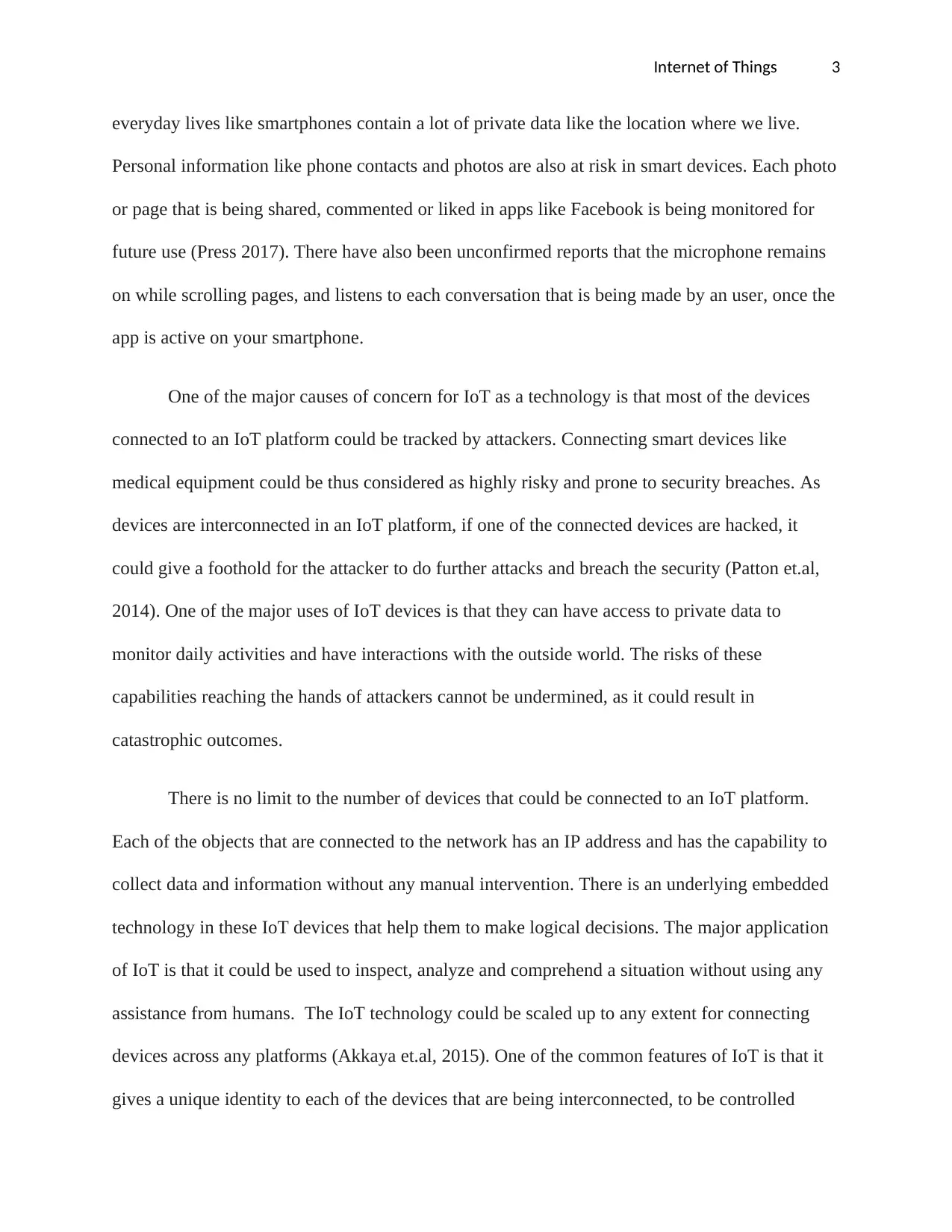
Internet of Things 3
everyday lives like smartphones contain a lot of private data like the location where we live.
Personal information like phone contacts and photos are also at risk in smart devices. Each photo
or page that is being shared, commented or liked in apps like Facebook is being monitored for
future use (Press 2017). There have also been unconfirmed reports that the microphone remains
on while scrolling pages, and listens to each conversation that is being made by an user, once the
app is active on your smartphone.
One of the major causes of concern for IoT as a technology is that most of the devices
connected to an IoT platform could be tracked by attackers. Connecting smart devices like
medical equipment could be thus considered as highly risky and prone to security breaches. As
devices are interconnected in an IoT platform, if one of the connected devices are hacked, it
could give a foothold for the attacker to do further attacks and breach the security (Patton et.al,
2014). One of the major uses of IoT devices is that they can have access to private data to
monitor daily activities and have interactions with the outside world. The risks of these
capabilities reaching the hands of attackers cannot be undermined, as it could result in
catastrophic outcomes.
There is no limit to the number of devices that could be connected to an IoT platform.
Each of the objects that are connected to the network has an IP address and has the capability to
collect data and information without any manual intervention. There is an underlying embedded
technology in these IoT devices that help them to make logical decisions. The major application
of IoT is that it could be used to inspect, analyze and comprehend a situation without using any
assistance from humans. The IoT technology could be scaled up to any extent for connecting
devices across any platforms (Akkaya et.al, 2015). One of the common features of IoT is that it
gives a unique identity to each of the devices that are being interconnected, to be controlled
everyday lives like smartphones contain a lot of private data like the location where we live.
Personal information like phone contacts and photos are also at risk in smart devices. Each photo
or page that is being shared, commented or liked in apps like Facebook is being monitored for
future use (Press 2017). There have also been unconfirmed reports that the microphone remains
on while scrolling pages, and listens to each conversation that is being made by an user, once the
app is active on your smartphone.
One of the major causes of concern for IoT as a technology is that most of the devices
connected to an IoT platform could be tracked by attackers. Connecting smart devices like
medical equipment could be thus considered as highly risky and prone to security breaches. As
devices are interconnected in an IoT platform, if one of the connected devices are hacked, it
could give a foothold for the attacker to do further attacks and breach the security (Patton et.al,
2014). One of the major uses of IoT devices is that they can have access to private data to
monitor daily activities and have interactions with the outside world. The risks of these
capabilities reaching the hands of attackers cannot be undermined, as it could result in
catastrophic outcomes.
There is no limit to the number of devices that could be connected to an IoT platform.
Each of the objects that are connected to the network has an IP address and has the capability to
collect data and information without any manual intervention. There is an underlying embedded
technology in these IoT devices that help them to make logical decisions. The major application
of IoT is that it could be used to inspect, analyze and comprehend a situation without using any
assistance from humans. The IoT technology could be scaled up to any extent for connecting
devices across any platforms (Akkaya et.al, 2015). One of the common features of IoT is that it
gives a unique identity to each of the devices that are being interconnected, to be controlled
⊘ This is a preview!⊘
Do you want full access?
Subscribe today to unlock all pages.

Trusted by 1+ million students worldwide
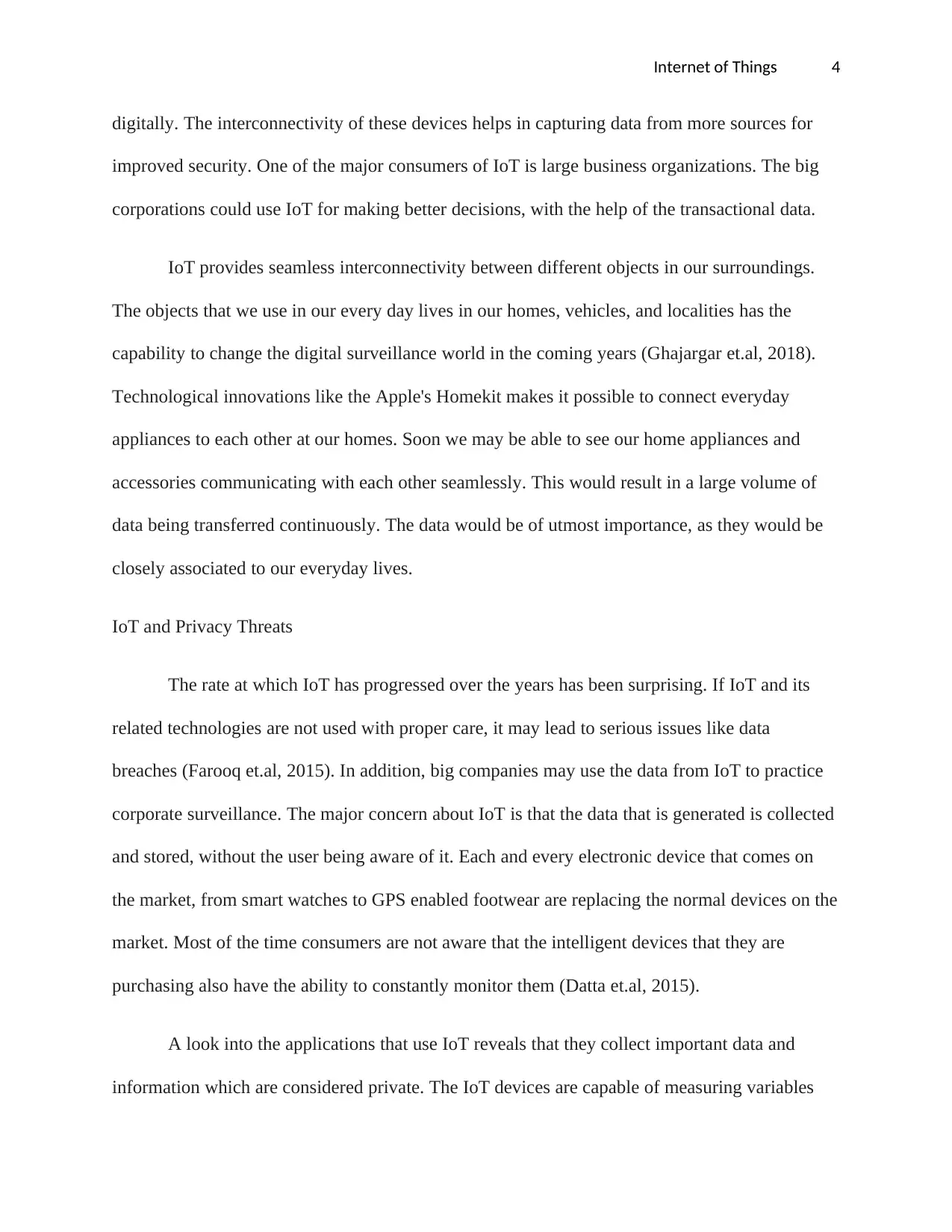
Internet of Things 4
digitally. The interconnectivity of these devices helps in capturing data from more sources for
improved security. One of the major consumers of IoT is large business organizations. The big
corporations could use IoT for making better decisions, with the help of the transactional data.
IoT provides seamless interconnectivity between different objects in our surroundings.
The objects that we use in our every day lives in our homes, vehicles, and localities has the
capability to change the digital surveillance world in the coming years (Ghajargar et.al, 2018).
Technological innovations like the Apple's Homekit makes it possible to connect everyday
appliances to each other at our homes. Soon we may be able to see our home appliances and
accessories communicating with each other seamlessly. This would result in a large volume of
data being transferred continuously. The data would be of utmost importance, as they would be
closely associated to our everyday lives.
IoT and Privacy Threats
The rate at which IoT has progressed over the years has been surprising. If IoT and its
related technologies are not used with proper care, it may lead to serious issues like data
breaches (Farooq et.al, 2015). In addition, big companies may use the data from IoT to practice
corporate surveillance. The major concern about IoT is that the data that is generated is collected
and stored, without the user being aware of it. Each and every electronic device that comes on
the market, from smart watches to GPS enabled footwear are replacing the normal devices on the
market. Most of the time consumers are not aware that the intelligent devices that they are
purchasing also have the ability to constantly monitor them (Datta et.al, 2015).
A look into the applications that use IoT reveals that they collect important data and
information which are considered private. The IoT devices are capable of measuring variables
digitally. The interconnectivity of these devices helps in capturing data from more sources for
improved security. One of the major consumers of IoT is large business organizations. The big
corporations could use IoT for making better decisions, with the help of the transactional data.
IoT provides seamless interconnectivity between different objects in our surroundings.
The objects that we use in our every day lives in our homes, vehicles, and localities has the
capability to change the digital surveillance world in the coming years (Ghajargar et.al, 2018).
Technological innovations like the Apple's Homekit makes it possible to connect everyday
appliances to each other at our homes. Soon we may be able to see our home appliances and
accessories communicating with each other seamlessly. This would result in a large volume of
data being transferred continuously. The data would be of utmost importance, as they would be
closely associated to our everyday lives.
IoT and Privacy Threats
The rate at which IoT has progressed over the years has been surprising. If IoT and its
related technologies are not used with proper care, it may lead to serious issues like data
breaches (Farooq et.al, 2015). In addition, big companies may use the data from IoT to practice
corporate surveillance. The major concern about IoT is that the data that is generated is collected
and stored, without the user being aware of it. Each and every electronic device that comes on
the market, from smart watches to GPS enabled footwear are replacing the normal devices on the
market. Most of the time consumers are not aware that the intelligent devices that they are
purchasing also have the ability to constantly monitor them (Datta et.al, 2015).
A look into the applications that use IoT reveals that they collect important data and
information which are considered private. The IoT devices are capable of measuring variables
Paraphrase This Document
Need a fresh take? Get an instant paraphrase of this document with our AI Paraphraser
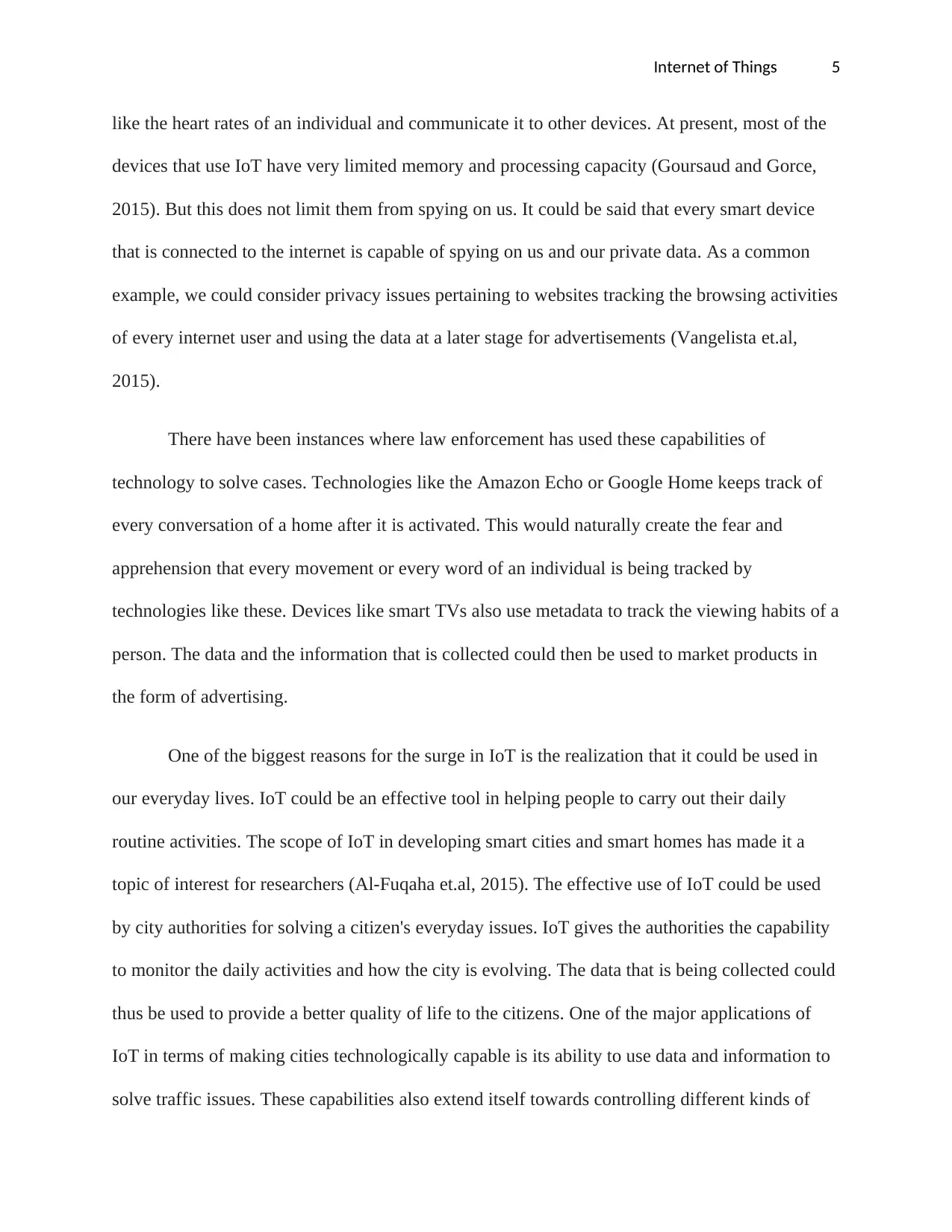
Internet of Things 5
like the heart rates of an individual and communicate it to other devices. At present, most of the
devices that use IoT have very limited memory and processing capacity (Goursaud and Gorce,
2015). But this does not limit them from spying on us. It could be said that every smart device
that is connected to the internet is capable of spying on us and our private data. As a common
example, we could consider privacy issues pertaining to websites tracking the browsing activities
of every internet user and using the data at a later stage for advertisements (Vangelista et.al,
2015).
There have been instances where law enforcement has used these capabilities of
technology to solve cases. Technologies like the Amazon Echo or Google Home keeps track of
every conversation of a home after it is activated. This would naturally create the fear and
apprehension that every movement or every word of an individual is being tracked by
technologies like these. Devices like smart TVs also use metadata to track the viewing habits of a
person. The data and the information that is collected could then be used to market products in
the form of advertising.
One of the biggest reasons for the surge in IoT is the realization that it could be used in
our everyday lives. IoT could be an effective tool in helping people to carry out their daily
routine activities. The scope of IoT in developing smart cities and smart homes has made it a
topic of interest for researchers (Al-Fuqaha et.al, 2015). The effective use of IoT could be used
by city authorities for solving a citizen's everyday issues. IoT gives the authorities the capability
to monitor the daily activities and how the city is evolving. The data that is being collected could
thus be used to provide a better quality of life to the citizens. One of the major applications of
IoT in terms of making cities technologically capable is its ability to use data and information to
solve traffic issues. These capabilities also extend itself towards controlling different kinds of
like the heart rates of an individual and communicate it to other devices. At present, most of the
devices that use IoT have very limited memory and processing capacity (Goursaud and Gorce,
2015). But this does not limit them from spying on us. It could be said that every smart device
that is connected to the internet is capable of spying on us and our private data. As a common
example, we could consider privacy issues pertaining to websites tracking the browsing activities
of every internet user and using the data at a later stage for advertisements (Vangelista et.al,
2015).
There have been instances where law enforcement has used these capabilities of
technology to solve cases. Technologies like the Amazon Echo or Google Home keeps track of
every conversation of a home after it is activated. This would naturally create the fear and
apprehension that every movement or every word of an individual is being tracked by
technologies like these. Devices like smart TVs also use metadata to track the viewing habits of a
person. The data and the information that is collected could then be used to market products in
the form of advertising.
One of the biggest reasons for the surge in IoT is the realization that it could be used in
our everyday lives. IoT could be an effective tool in helping people to carry out their daily
routine activities. The scope of IoT in developing smart cities and smart homes has made it a
topic of interest for researchers (Al-Fuqaha et.al, 2015). The effective use of IoT could be used
by city authorities for solving a citizen's everyday issues. IoT gives the authorities the capability
to monitor the daily activities and how the city is evolving. The data that is being collected could
thus be used to provide a better quality of life to the citizens. One of the major applications of
IoT in terms of making cities technologically capable is its ability to use data and information to
solve traffic issues. These capabilities also extend itself towards controlling different kinds of
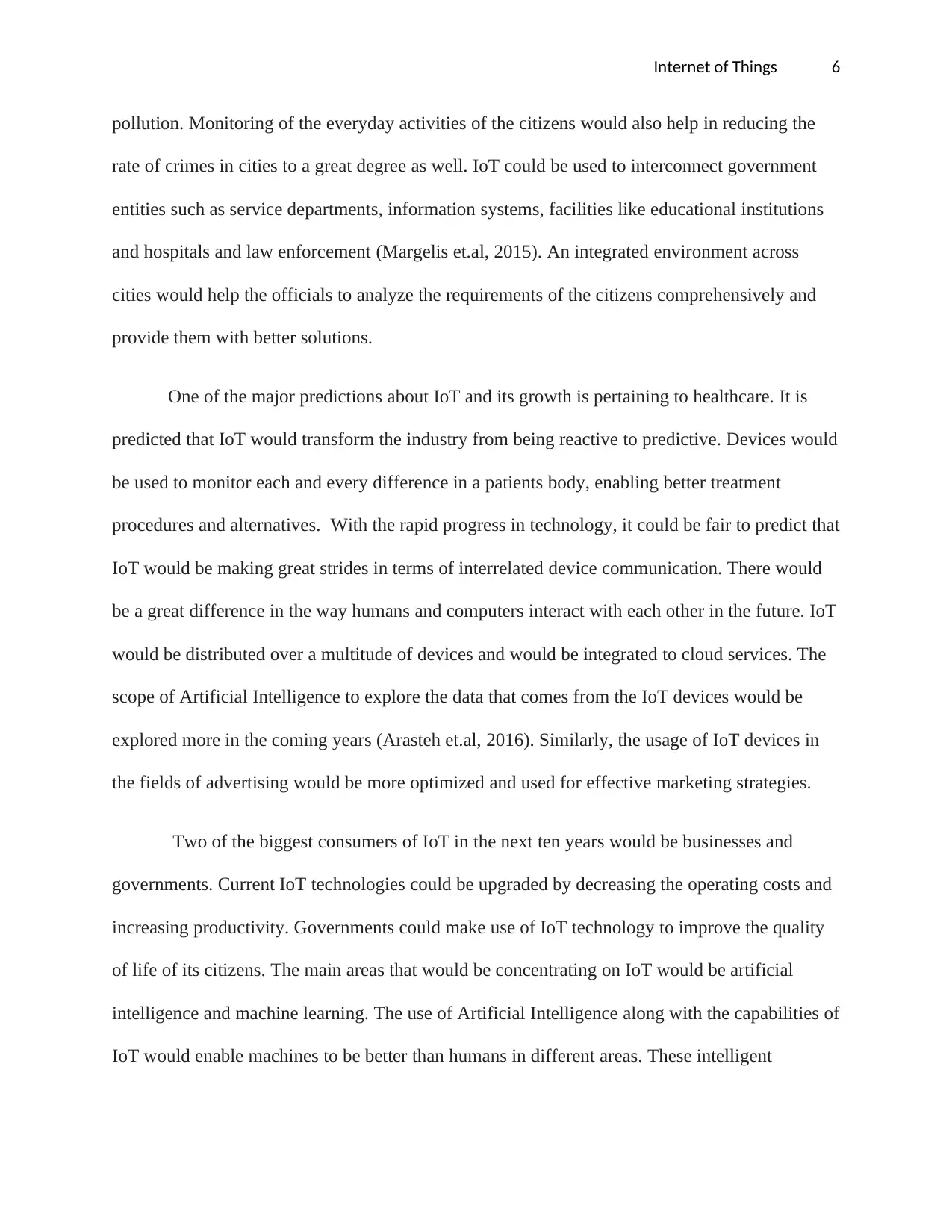
Internet of Things 6
pollution. Monitoring of the everyday activities of the citizens would also help in reducing the
rate of crimes in cities to a great degree as well. IoT could be used to interconnect government
entities such as service departments, information systems, facilities like educational institutions
and hospitals and law enforcement (Margelis et.al, 2015). An integrated environment across
cities would help the officials to analyze the requirements of the citizens comprehensively and
provide them with better solutions.
One of the major predictions about IoT and its growth is pertaining to healthcare. It is
predicted that IoT would transform the industry from being reactive to predictive. Devices would
be used to monitor each and every difference in a patients body, enabling better treatment
procedures and alternatives. With the rapid progress in technology, it could be fair to predict that
IoT would be making great strides in terms of interrelated device communication. There would
be a great difference in the way humans and computers interact with each other in the future. IoT
would be distributed over a multitude of devices and would be integrated to cloud services. The
scope of Artificial Intelligence to explore the data that comes from the IoT devices would be
explored more in the coming years (Arasteh et.al, 2016). Similarly, the usage of IoT devices in
the fields of advertising would be more optimized and used for effective marketing strategies.
Two of the biggest consumers of IoT in the next ten years would be businesses and
governments. Current IoT technologies could be upgraded by decreasing the operating costs and
increasing productivity. Governments could make use of IoT technology to improve the quality
of life of its citizens. The main areas that would be concentrating on IoT would be artificial
intelligence and machine learning. The use of Artificial Intelligence along with the capabilities of
IoT would enable machines to be better than humans in different areas. These intelligent
pollution. Monitoring of the everyday activities of the citizens would also help in reducing the
rate of crimes in cities to a great degree as well. IoT could be used to interconnect government
entities such as service departments, information systems, facilities like educational institutions
and hospitals and law enforcement (Margelis et.al, 2015). An integrated environment across
cities would help the officials to analyze the requirements of the citizens comprehensively and
provide them with better solutions.
One of the major predictions about IoT and its growth is pertaining to healthcare. It is
predicted that IoT would transform the industry from being reactive to predictive. Devices would
be used to monitor each and every difference in a patients body, enabling better treatment
procedures and alternatives. With the rapid progress in technology, it could be fair to predict that
IoT would be making great strides in terms of interrelated device communication. There would
be a great difference in the way humans and computers interact with each other in the future. IoT
would be distributed over a multitude of devices and would be integrated to cloud services. The
scope of Artificial Intelligence to explore the data that comes from the IoT devices would be
explored more in the coming years (Arasteh et.al, 2016). Similarly, the usage of IoT devices in
the fields of advertising would be more optimized and used for effective marketing strategies.
Two of the biggest consumers of IoT in the next ten years would be businesses and
governments. Current IoT technologies could be upgraded by decreasing the operating costs and
increasing productivity. Governments could make use of IoT technology to improve the quality
of life of its citizens. The main areas that would be concentrating on IoT would be artificial
intelligence and machine learning. The use of Artificial Intelligence along with the capabilities of
IoT would enable machines to be better than humans in different areas. These intelligent
⊘ This is a preview!⊘
Do you want full access?
Subscribe today to unlock all pages.

Trusted by 1+ million students worldwide
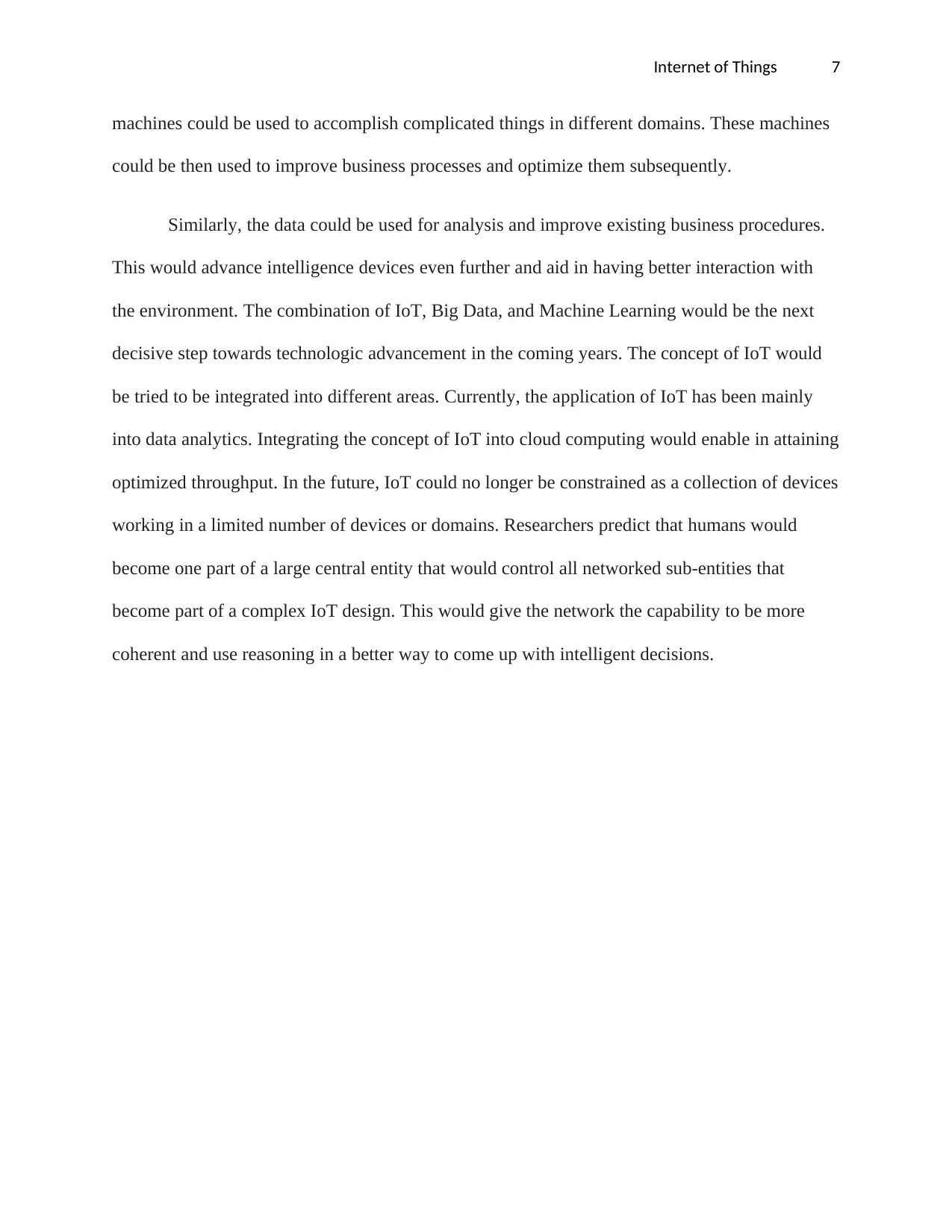
Internet of Things 7
machines could be used to accomplish complicated things in different domains. These machines
could be then used to improve business processes and optimize them subsequently.
Similarly, the data could be used for analysis and improve existing business procedures.
This would advance intelligence devices even further and aid in having better interaction with
the environment. The combination of IoT, Big Data, and Machine Learning would be the next
decisive step towards technologic advancement in the coming years. The concept of IoT would
be tried to be integrated into different areas. Currently, the application of IoT has been mainly
into data analytics. Integrating the concept of IoT into cloud computing would enable in attaining
optimized throughput. In the future, IoT could no longer be constrained as a collection of devices
working in a limited number of devices or domains. Researchers predict that humans would
become one part of a large central entity that would control all networked sub-entities that
become part of a complex IoT design. This would give the network the capability to be more
coherent and use reasoning in a better way to come up with intelligent decisions.
machines could be used to accomplish complicated things in different domains. These machines
could be then used to improve business processes and optimize them subsequently.
Similarly, the data could be used for analysis and improve existing business procedures.
This would advance intelligence devices even further and aid in having better interaction with
the environment. The combination of IoT, Big Data, and Machine Learning would be the next
decisive step towards technologic advancement in the coming years. The concept of IoT would
be tried to be integrated into different areas. Currently, the application of IoT has been mainly
into data analytics. Integrating the concept of IoT into cloud computing would enable in attaining
optimized throughput. In the future, IoT could no longer be constrained as a collection of devices
working in a limited number of devices or domains. Researchers predict that humans would
become one part of a large central entity that would control all networked sub-entities that
become part of a complex IoT design. This would give the network the capability to be more
coherent and use reasoning in a better way to come up with intelligent decisions.
Paraphrase This Document
Need a fresh take? Get an instant paraphrase of this document with our AI Paraphraser
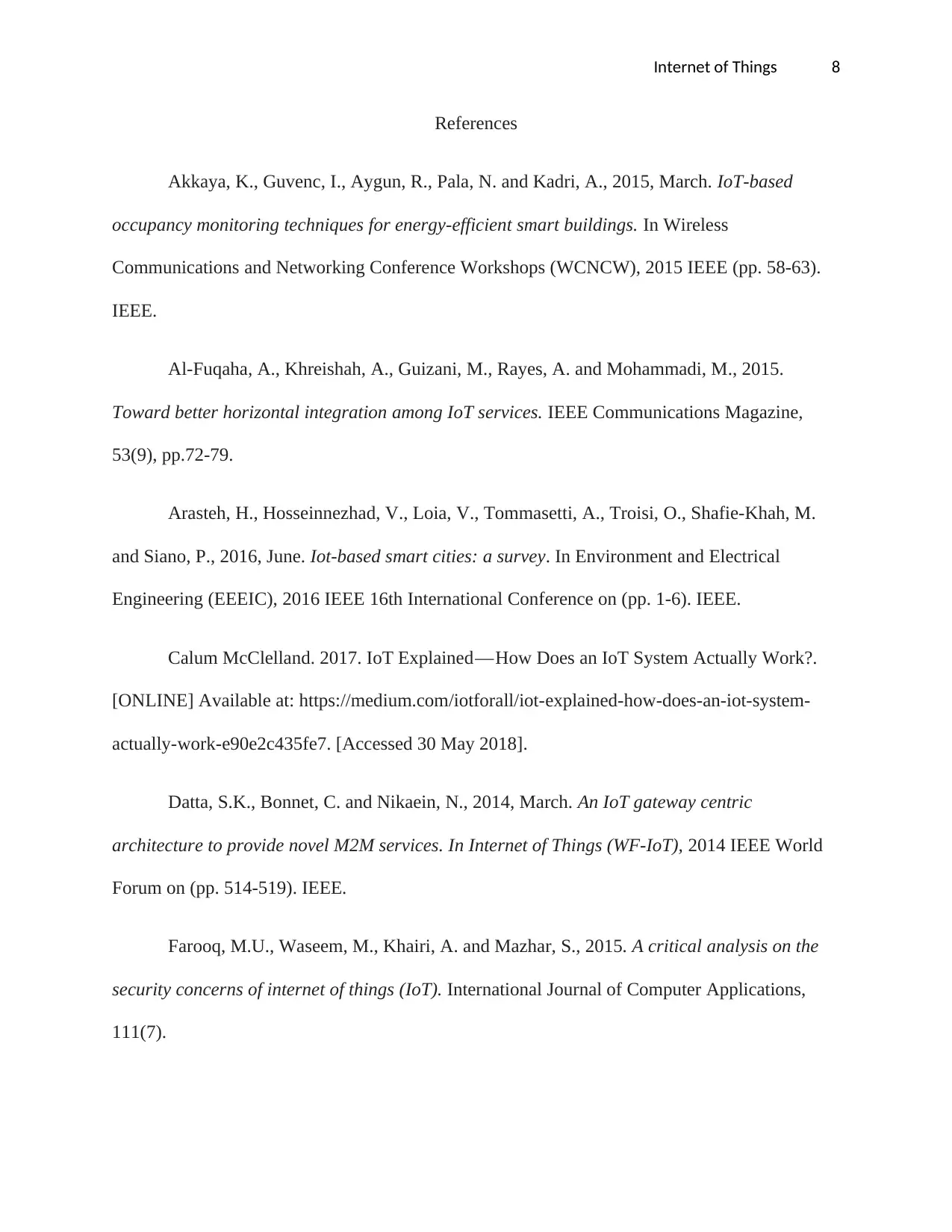
Internet of Things 8
References
Akkaya, K., Guvenc, I., Aygun, R., Pala, N. and Kadri, A., 2015, March. IoT-based
occupancy monitoring techniques for energy-efficient smart buildings. In Wireless
Communications and Networking Conference Workshops (WCNCW), 2015 IEEE (pp. 58-63).
IEEE.
Al-Fuqaha, A., Khreishah, A., Guizani, M., Rayes, A. and Mohammadi, M., 2015.
Toward better horizontal integration among IoT services. IEEE Communications Magazine,
53(9), pp.72-79.
Arasteh, H., Hosseinnezhad, V., Loia, V., Tommasetti, A., Troisi, O., Shafie-Khah, M.
and Siano, P., 2016, June. Iot-based smart cities: a survey. In Environment and Electrical
Engineering (EEEIC), 2016 IEEE 16th International Conference on (pp. 1-6). IEEE.
Calum McClelland. 2017. IoT Explained — How Does an IoT System Actually Work?.
[ONLINE] Available at: https://medium.com/iotforall/iot-explained-how-does-an-iot-system-
actually-work-e90e2c435fe7. [Accessed 30 May 2018].
Datta, S.K., Bonnet, C. and Nikaein, N., 2014, March. An IoT gateway centric
architecture to provide novel M2M services. In Internet of Things (WF-IoT), 2014 IEEE World
Forum on (pp. 514-519). IEEE.
Farooq, M.U., Waseem, M., Khairi, A. and Mazhar, S., 2015. A critical analysis on the
security concerns of internet of things (IoT). International Journal of Computer Applications,
111(7).
References
Akkaya, K., Guvenc, I., Aygun, R., Pala, N. and Kadri, A., 2015, March. IoT-based
occupancy monitoring techniques for energy-efficient smart buildings. In Wireless
Communications and Networking Conference Workshops (WCNCW), 2015 IEEE (pp. 58-63).
IEEE.
Al-Fuqaha, A., Khreishah, A., Guizani, M., Rayes, A. and Mohammadi, M., 2015.
Toward better horizontal integration among IoT services. IEEE Communications Magazine,
53(9), pp.72-79.
Arasteh, H., Hosseinnezhad, V., Loia, V., Tommasetti, A., Troisi, O., Shafie-Khah, M.
and Siano, P., 2016, June. Iot-based smart cities: a survey. In Environment and Electrical
Engineering (EEEIC), 2016 IEEE 16th International Conference on (pp. 1-6). IEEE.
Calum McClelland. 2017. IoT Explained — How Does an IoT System Actually Work?.
[ONLINE] Available at: https://medium.com/iotforall/iot-explained-how-does-an-iot-system-
actually-work-e90e2c435fe7. [Accessed 30 May 2018].
Datta, S.K., Bonnet, C. and Nikaein, N., 2014, March. An IoT gateway centric
architecture to provide novel M2M services. In Internet of Things (WF-IoT), 2014 IEEE World
Forum on (pp. 514-519). IEEE.
Farooq, M.U., Waseem, M., Khairi, A. and Mazhar, S., 2015. A critical analysis on the
security concerns of internet of things (IoT). International Journal of Computer Applications,
111(7).
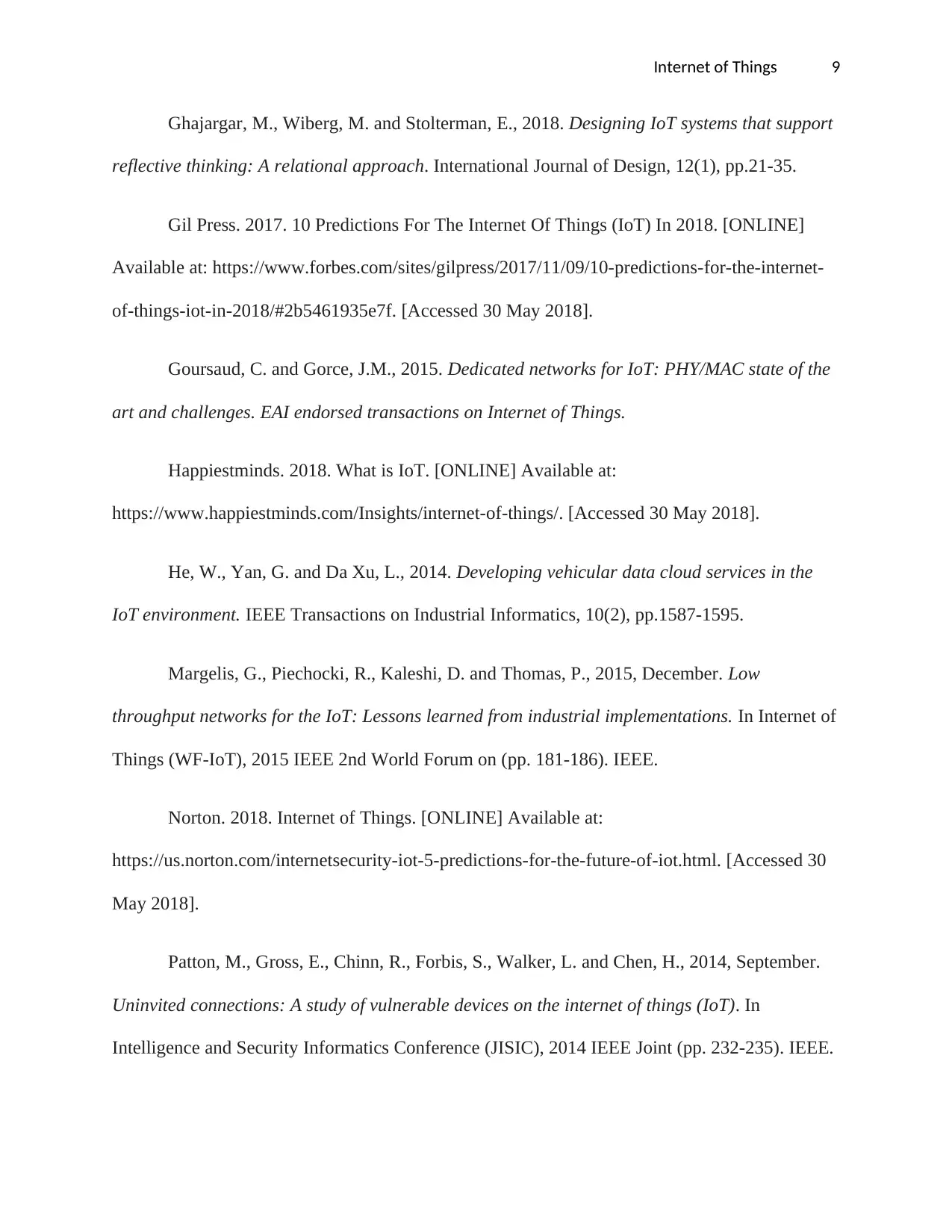
Internet of Things 9
Ghajargar, M., Wiberg, M. and Stolterman, E., 2018. Designing IoT systems that support
reflective thinking: A relational approach. International Journal of Design, 12(1), pp.21-35.
Gil Press. 2017. 10 Predictions For The Internet Of Things (IoT) In 2018. [ONLINE]
Available at: https://www.forbes.com/sites/gilpress/2017/11/09/10-predictions-for-the-internet-
of-things-iot-in-2018/#2b5461935e7f. [Accessed 30 May 2018].
Goursaud, C. and Gorce, J.M., 2015. Dedicated networks for IoT: PHY/MAC state of the
art and challenges. EAI endorsed transactions on Internet of Things.
Happiestminds. 2018. What is IoT. [ONLINE] Available at:
https://www.happiestminds.com/Insights/internet-of-things/. [Accessed 30 May 2018].
He, W., Yan, G. and Da Xu, L., 2014. Developing vehicular data cloud services in the
IoT environment. IEEE Transactions on Industrial Informatics, 10(2), pp.1587-1595.
Margelis, G., Piechocki, R., Kaleshi, D. and Thomas, P., 2015, December. Low
throughput networks for the IoT: Lessons learned from industrial implementations. In Internet of
Things (WF-IoT), 2015 IEEE 2nd World Forum on (pp. 181-186). IEEE.
Norton. 2018. Internet of Things. [ONLINE] Available at:
https://us.norton.com/internetsecurity-iot-5-predictions-for-the-future-of-iot.html. [Accessed 30
May 2018].
Patton, M., Gross, E., Chinn, R., Forbis, S., Walker, L. and Chen, H., 2014, September.
Uninvited connections: A study of vulnerable devices on the internet of things (IoT). In
Intelligence and Security Informatics Conference (JISIC), 2014 IEEE Joint (pp. 232-235). IEEE.
Ghajargar, M., Wiberg, M. and Stolterman, E., 2018. Designing IoT systems that support
reflective thinking: A relational approach. International Journal of Design, 12(1), pp.21-35.
Gil Press. 2017. 10 Predictions For The Internet Of Things (IoT) In 2018. [ONLINE]
Available at: https://www.forbes.com/sites/gilpress/2017/11/09/10-predictions-for-the-internet-
of-things-iot-in-2018/#2b5461935e7f. [Accessed 30 May 2018].
Goursaud, C. and Gorce, J.M., 2015. Dedicated networks for IoT: PHY/MAC state of the
art and challenges. EAI endorsed transactions on Internet of Things.
Happiestminds. 2018. What is IoT. [ONLINE] Available at:
https://www.happiestminds.com/Insights/internet-of-things/. [Accessed 30 May 2018].
He, W., Yan, G. and Da Xu, L., 2014. Developing vehicular data cloud services in the
IoT environment. IEEE Transactions on Industrial Informatics, 10(2), pp.1587-1595.
Margelis, G., Piechocki, R., Kaleshi, D. and Thomas, P., 2015, December. Low
throughput networks for the IoT: Lessons learned from industrial implementations. In Internet of
Things (WF-IoT), 2015 IEEE 2nd World Forum on (pp. 181-186). IEEE.
Norton. 2018. Internet of Things. [ONLINE] Available at:
https://us.norton.com/internetsecurity-iot-5-predictions-for-the-future-of-iot.html. [Accessed 30
May 2018].
Patton, M., Gross, E., Chinn, R., Forbis, S., Walker, L. and Chen, H., 2014, September.
Uninvited connections: A study of vulnerable devices on the internet of things (IoT). In
Intelligence and Security Informatics Conference (JISIC), 2014 IEEE Joint (pp. 232-235). IEEE.
⊘ This is a preview!⊘
Do you want full access?
Subscribe today to unlock all pages.

Trusted by 1+ million students worldwide
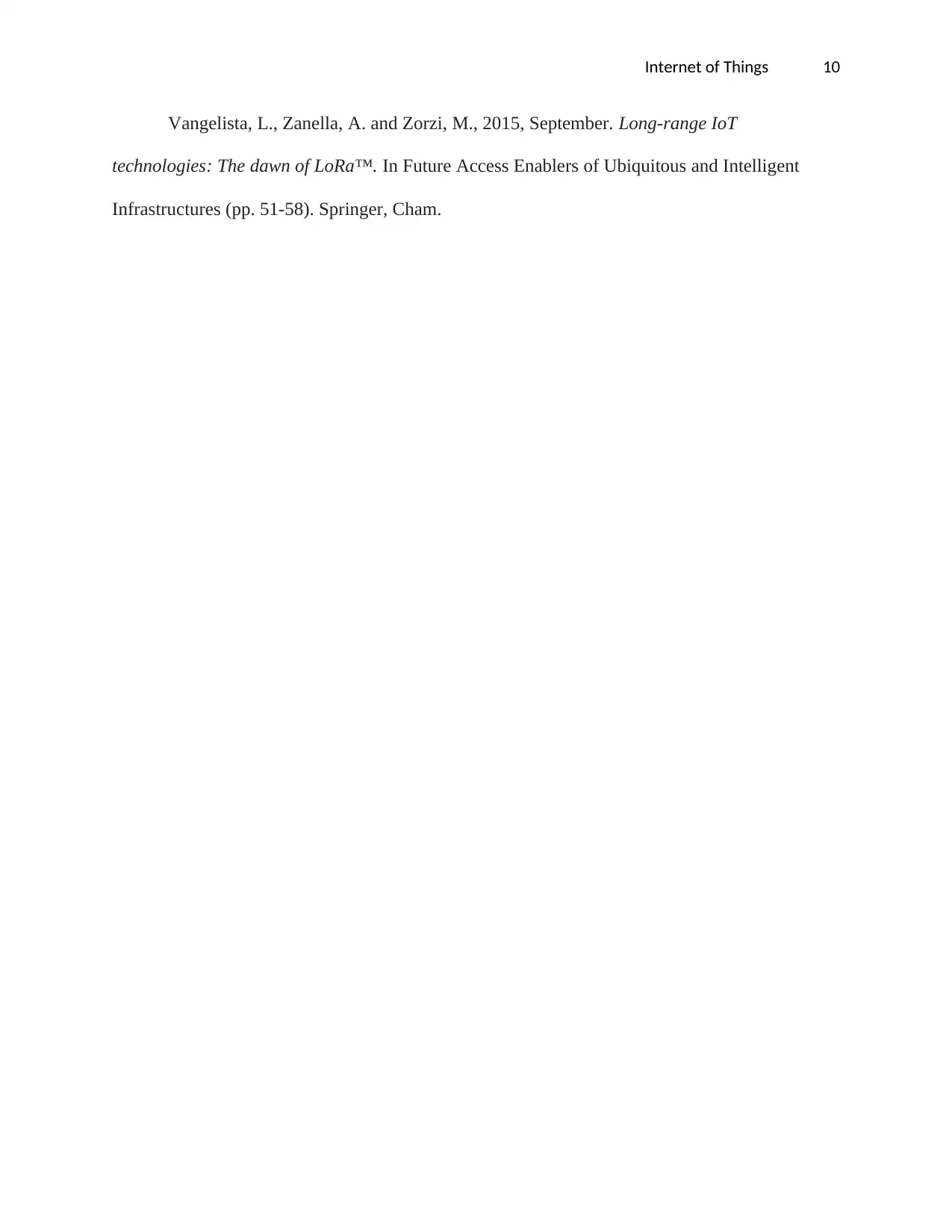
Internet of Things 10
Vangelista, L., Zanella, A. and Zorzi, M., 2015, September. Long-range IoT
technologies: The dawn of LoRa™. In Future Access Enablers of Ubiquitous and Intelligent
Infrastructures (pp. 51-58). Springer, Cham.
Vangelista, L., Zanella, A. and Zorzi, M., 2015, September. Long-range IoT
technologies: The dawn of LoRa™. In Future Access Enablers of Ubiquitous and Intelligent
Infrastructures (pp. 51-58). Springer, Cham.
1 out of 10
Related Documents
Your All-in-One AI-Powered Toolkit for Academic Success.
+13062052269
info@desklib.com
Available 24*7 on WhatsApp / Email
![[object Object]](/_next/static/media/star-bottom.7253800d.svg)
Unlock your academic potential
Copyright © 2020–2025 A2Z Services. All Rights Reserved. Developed and managed by ZUCOL.





